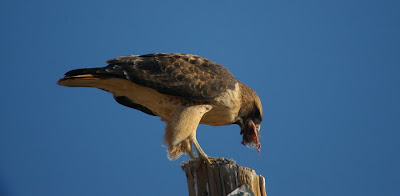I've finally gotten around to reviewing the hundreds of photos I shot while on my recent vacation to Central America. Photographing wildlife was a real challenge due to lack of light in the forests and an abundance of rain on many occasions. The photos below are just a sliver of the animals we enjoyed on this trip, be it in the forests, skies, or seas.
This is a spiny-tailed iguana shot at Manuel Antonio National Park. One of the naturalists from our ship said that these are prized for their meat by some of the locals.
A Capuchin or White-faced Monkey, also shot at Manuel Antonio. These guys were everywhere and quite easy to approach. We were advised to keep a close eye on backpacks, cameras, and binoculars, as it was not uncommon for an inquisitive monkey to make off with someone's gear.

The Crab-eating Raccoon is found only along the Pacific coast of Costa Rica and is closely related to the ubiquitous Northern Raccoon, common to exotic locales such as Mount
Horeb, WI.

This is a Three-fingered Sloth. What can I say about sloths other than they are such cool and
bizarre creatures. Sloths are also a favorite food of the Harpy Eagle, the national bird of Panama.

The Marbled Wood-quail is a very elusive, chicken-like ground forager. I was told that many birders in Costa Rica
seldom if ever get a chance to view one of these shy creatures. I felt pretty lucky when we were able to watch a small covey hunt amongst the leaf litter within 15 feet of us and tried to get a decent photo. This was the best I could do with the lack of light.

This is a Jesus Christ Lizard, named as such because it escapes predators by running across water on its hind legs.

A Spotted Sandpiper in winter plumage.

Chestnut-mandibled Toucan.

We had spent a day in the Darien Jungle with the indigenous people of the Embera village. Here is a picture of a group of children enjoying close-up views of a Night Monkey through my scope.

Night Monkeys (also called owl monkeys) are a nocturnal species. If I recall correctly, the night monkey is the only nocturnal species of monkey.

The list of those species seen but not photographed is too long to post, especially when we get to the bird species.
As I look back on our trip, I am continually amazed at both the diversity and abundance of life present in such a small geographical area. Having said that, both Panama and Costa Rica face continual pressure for development of land for housing, industry, and agriculture. A bright spot here is that both countries have recognized the value of eco-tourism to their economies and have protected large tracts of land to try and insure its future. My hope and belief is that their reverence for wild things will continue to keep in check the tempting desire for wealth easily obtained by exploiting the land. I highly encourage you to help keep these places wild by visiting and supporting the eco-tourism industry in Central America. It's worth it!
 I'm a huge fan of illustration, including comic books. Diana's illustrations bring together elements of a lot of my favorite things: nature, art, science, music, and whimsy. Her work reminds me of a mix between the stylized drawings of John James Audubon and Edward Gorey.
I'm a huge fan of illustration, including comic books. Diana's illustrations bring together elements of a lot of my favorite things: nature, art, science, music, and whimsy. Her work reminds me of a mix between the stylized drawings of John James Audubon and Edward Gorey.







 The Crab-eating Raccoon is found only along the Pacific coast of Costa Rica and is closely related to the ubiquitous Northern Raccoon, common to exotic locales such as Mount
The Crab-eating Raccoon is found only along the Pacific coast of Costa Rica and is closely related to the ubiquitous Northern Raccoon, common to exotic locales such as Mount  This is a Three-fingered Sloth. What can I say about sloths other than they are such cool and
This is a Three-fingered Sloth. What can I say about sloths other than they are such cool and  The Marbled Wood-quail is a very elusive, chicken-like ground forager. I was told that many birders in Costa Rica
The Marbled Wood-quail is a very elusive, chicken-like ground forager. I was told that many birders in Costa Rica  This is a Jesus Christ Lizard, named as such because it escapes predators by running across water on its hind legs.
This is a Jesus Christ Lizard, named as such because it escapes predators by running across water on its hind legs.




































